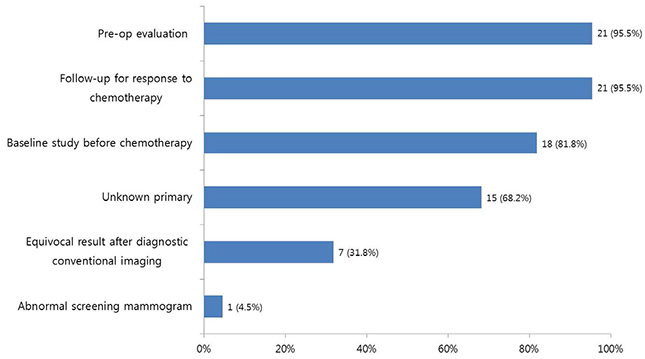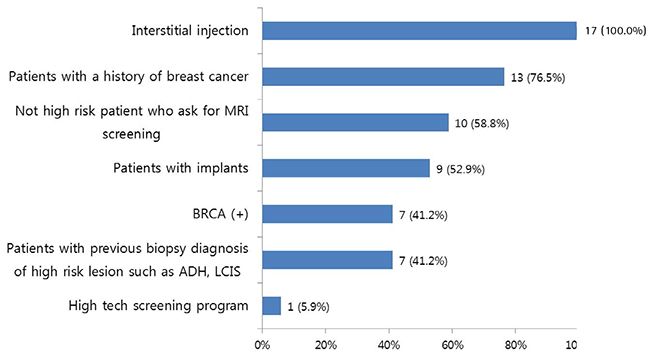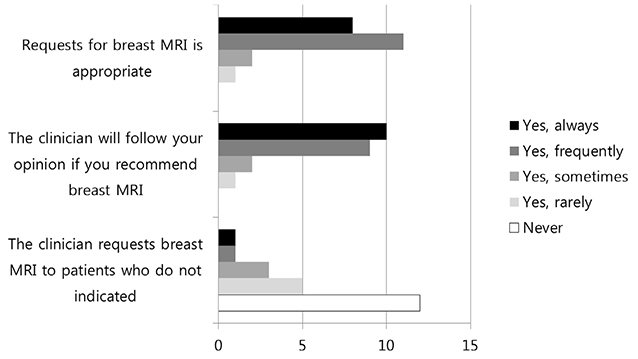Investig Magn Reson Imaging.
2017 Dec;21(4):233-241. 10.13104/imri.2017.21.4.233.
Current Practices in Breast Magnetic Resonance Imaging: a Survey Involving the Korean Society of Breast Imaging
- Affiliations
-
- 1Department of Radiology, Seoul National University Bundang Hospital, Seongnam-si, Korea. kimsmlms@daum.net
- 2Department of Radiology, Seoul St. Mary's Hospital, College of Medicine, The Catholic University of Korea, Seoul, Korea.
- 3Department of Radiology, Seoul National University College of Medicine, Seoul, Korea.
- 4Department of Radiology, Hanyang University Hospital, Seoul, Korea.
- 5Department of Radiology and Research Institute of Radiology, Asan Medical Center, University of Ulsan, College of Medicine, Seoul, Korea.
- 6Department of Radiology, Samsung Medical Center, Sungkyunkwan University School of Medicine, Seoul, Korea.
- KMID: 2400377
- DOI: http://doi.org/10.13104/imri.2017.21.4.233
Abstract
- PURPOSE
To report on the current practices in breast magnetic resonance imaging (MRI) in Korea.
MATERIALS AND METHODS
We invited the 68 members of the Korean Society of Breast Imaging who were working in hospitals with available breast MRI to participate in a survey on how they performed and interpreted breast MRI. We asked one member from each hospital to respond to the survey. A total of 22 surveys from 22 hospitals were analyzed.
RESULTS
Out of 22 hospitals, 13 (59.1%) performed at least 300 breast MRI examinations per year, and 5 out of 22 (22.7%) performed > 1200 per year. Out of 31 machines, 14 (45.2%) machines were 1.5-T scanners and 17 (54.8%) were 3.0-T scanners. All hospitals did contrast-enhanced breast MRI. Full-time breast radiologists supervised the performance and interpreted breast MRI in 19 of 22 (86.4%) of hospitals. All hospitals used BI-RADS for MRI interpretation. For computer-aided detection (CAD), 13 (59.1%) hospitals sometimes or always use it and 9 (40.9%) hospitals did not use CAD. Two (9.1%) and twelve (54.5%) hospitals never and rarely interpreted breast MRI without correlating the mammography or ultrasound, respectively. The majority of respondents rarely (13/21, 61.9%) or never (5/21, 23.8%) interpreted breast MRI performed at an outside facility. Of the hospitals performing contrast-enhanced examinations, 15 of 22 (68.2%) did not perform MRI-guided interventional procedures.
CONCLUSION
Breast MRI is extensively performed in Korea. The indication and practical patterns are diverse. The information from this survey would provide the basis for the development of Korean breast MRI practice guidelines.
MeSH Terms
Figure
Reference
-
1. National Cancer Statistics in Korea. Korean statistical information service Web site. 2014 [Published December 30, 2016]. [Accessed September 24, 2017]. http://kosis.kr.2. Kuhl CK, Schrading S, Leutner CC, et al. Mammography, breast ultrasound, and magnetic resonance imaging for surveillance of women at high familial risk for breast cancer. J Clin Oncol. 2005; 23:8469–8476.
Article3. Plana MN, Carreira C, Muriel A, et al. Magnetic resonance imaging in the preoperative assessment of patients with primary breast cancer: systematic review of diagnostic accuracy and meta-analysis. Eur Radiol. 2012; 22:26–38.
Article4. Hylton NM, Gatsonis CA, Rosen MA, et al. Neoadjuvant chemotherapy for breast cancer: functional tumor volume by mr imaging predicts recurrence-free survival-results from the ACRIN 6657/CALGB 150007 I-SPY 1 TRIAL. Radiology. 2016; 279:44–55.
Article5. Cho N, Han W, Han BK, et al. Breast cancer screening with mammography plus ultrasonography or magnetic resonance imaging in women 50 years or younger at diagnosis and treated with breast conservation therapy. JAMA Oncol. 2017; [Epub ahead of print].
Article6. Saslow D, Boetes C, Burke W, et al. American Cancer Society guidelines for breast screening with MRI as an adjunct to mammography. CA Cancer J Clin. 2007; 57:75–89.
Article7. Morris EA, Comstock CE, Lee CH, et al. ACR BI-RADS® Magnetic Resonance Imaging. In: ACR BI-RADS® Atlas, Breast Imaging Reporting and Data System. Reston, VA: American College of Radiology; 2013.8. Bassett LW, Dhaliwal SG, Eradat J, et al. National trends and practices in breast MRI. AJR Am J Roentgenol. 2008; 191:332–339.
Article9. Healthcare Bigdata Hub. Website; [Accessed September 24, 2017]. http://opendata.hira.or.kr.10. Warner E, Plewes DB, Shumak RS, et al. Comparison of breast magnetic resonance imaging, mammography, and ultrasound for surveillance of women at high risk for hereditary breast cancer. J Clin Oncol. 2001; 19:3524–3531.
Article11. Kuhl CK, Schmutzler RK, Leutner CC, et al. Breast MR imaging screening in 192 women proved or suspected to be carriers of a breast cancer susceptibility gene: preliminary results. Radiology. 2000; 215:267–279.
Article12. Stoutjesdijk MJ, Boetes C, Jager GJ, et al. Magnetic resonance imaging and mammography in women with a hereditary risk of breast cancer. J Natl Cancer Inst. 2001; 93:1095–1102.
Article13. ACR practice parameter for the performance of contrast-enhanced magnetic resonance imaging (MRI) of the breast. Website; [Published 2013]. [Accessed September 24, 2017]. https://www.acr.org/~/media/2a0eb28eb59041e2825179afb72ef624.pdf.
- Full Text Links
- Actions
-
Cited
- CITED
-
- Close
- Share
- Similar articles
-
- A Rare Case of Male Primary Breast Lymphoma
- Hemangiomas with the Variable Manifestations on Breast Imaging: Three Case Reports
- Breast Magnetic Resonance Image (MRI) Guideline: Breast Imaging Study Group of Korean Society of Magnetic Resonance in Medicine Recommendations
- A Survey on Current Trends of Breast Imaging Practices in Korea
- Optical Imaging of the Breast




